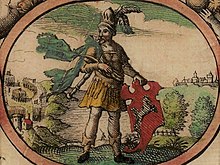

Hengist and Horsa are Germanic brothers said to have led the Angles, Saxons and Jutes in their supposed invasion of Britain in the 5th century. Tradition[clarification needed] lists Hengist as the first of the Jutish kings of Kent.
Modern scholarly consensus regards Hengist and Horsa as mythical figures, given their alliterative animal names, the seemingly constructed nature of their genealogy, and the unknowable quality of Bede's sources.[1] Their later detailed representation in texts such as the Anglo-Saxon Chronicle says more about ninth-century attitudes to the past than about the time in which they are said to have existed.[2][3]
According to early sources,[which?] Hengist and Horsa arrived in Britain at Ebbsfleet on the Isle of Thanet. For a time, they served as mercenaries for Vortigern, King of the Britons, but later they turned against him (British accounts have them betraying him in the Treachery of the Long Knives). Horsa was killed fighting the Britons, but Hengist successfully conquered Kent, becoming the forefather of its kings.
A figure named Hengest, possibly identifiable with the leader of British legend, appears in the Finnesburg Fragment and in Beowulf. J. R. R. Tolkien has theorized that this indicates Hengest/Hengist is the same person and originates as a historical person.[4]
Hengist was historically[clarification needed] said to have been buried at Hengistbury Head in Dorset.
- ^ Halsall (2013:60-62).
- ^ Yorke (1993).
- ^ Harland (2021:32).
- ^ Tolkien, J.R.R. (1982). Finn and Hengest. George Allen & Unwin. ISBN 0-0482-9003-3. (based on lectures delivered just before and after WWII)